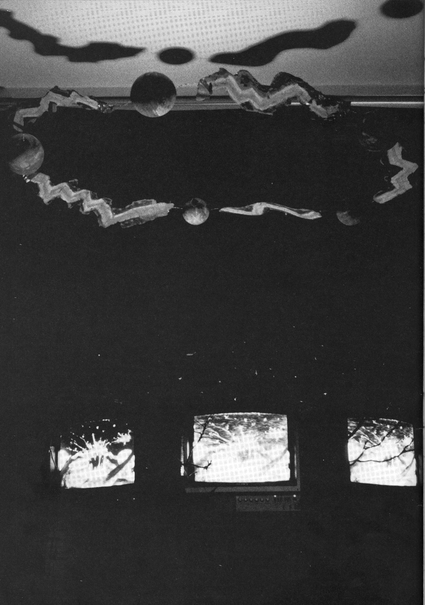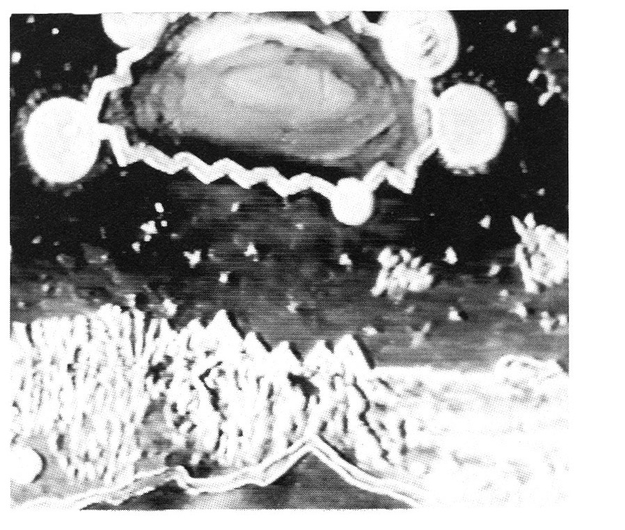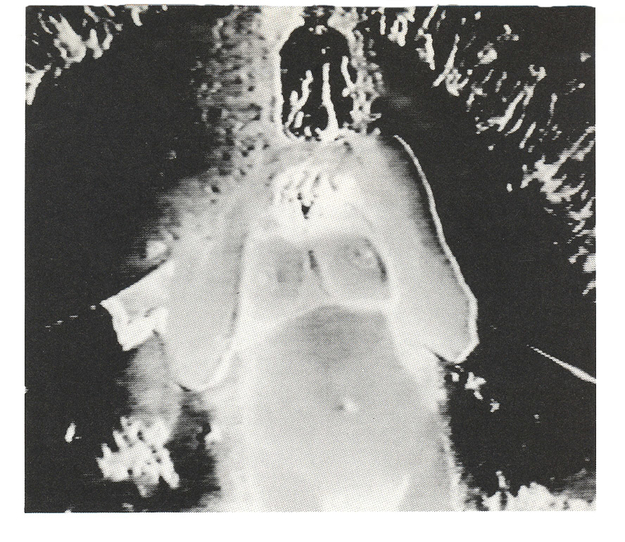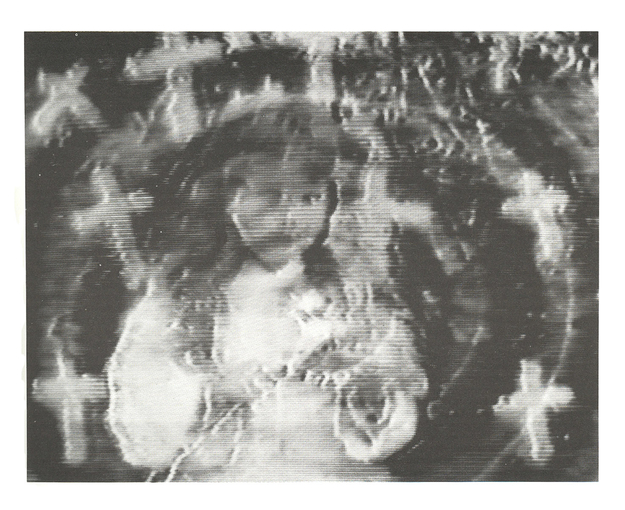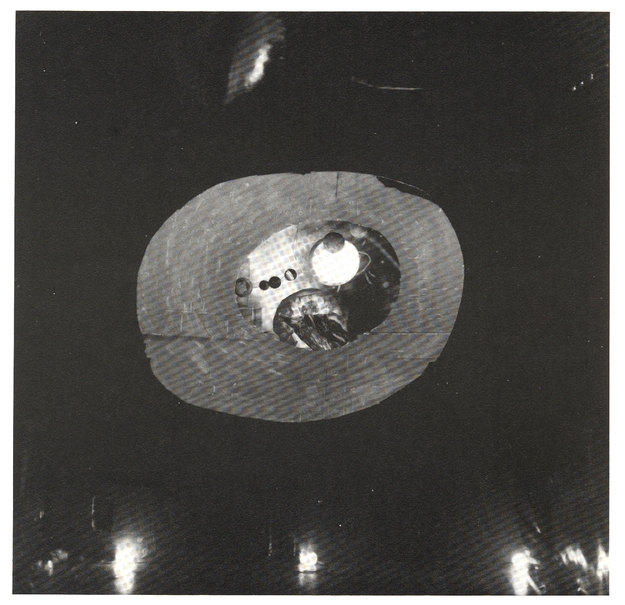Installation as shown at the Gemeente Museum Den Haag, 1986. A large cabinet, lined inside with black cloth. The front closed by black curtains. In the cabinet are five monitors. The middle three are placed on a platform and surrounded by branches. A crown of planet-like spheres, interconnected by cardboard-thunderbolts, is suspended near the ceiling. The middle three screens show ritual performances and refer to the interchangeability of man and woman. Often the picture decays into abstract moving expanses of colour in bright blue or pink. The other monitors create a landscape with rocks, rubble, puddles and waving ears of corn. The videoscenes are echoed in the installation as the branches through which the monitors glimmer and as the spheres which expand like a galaxy overhead.
I expected, that when KEES DE GROOT presented his new work in January 1986 at MONTEVIDEO in Amsterdam, he would have continued where he had left off one year ago. To be more specific, I had expected that he would have continued employing pre-historic, classical and medieval elements. However in this I was to be disappointed. He had transformed MONTEVIDEO top floor into a dark cave with psychedelic sounds, and it appeared that the opening scene had been inspired by spacecraft, as usually seen in science-fiction movies. Apparently DE GROOT has made a giant leap through the ages and had landed in the late sixties or early seventies. Only the space-cake and incense were missing. So much for the art historian who will always be looking for and expecting continuity. But the psychedelic introduction served to eradicate all my biased expectations and thus enabled me to become completely absorbed in the performance.
This year the installations by DE GROOT and FRANK MORSSINKHOF have been quite popular. Minski de Reus had only one viewing but the four installations, De vrouw van het Valtherpad, Cosmic Sperm, Polar (she is a) Flower and Jeder das Seine appeared several times. The works have consistently been adapted to their surroundings at every showing so they do not possess a fixed form. Each time the work is exhibited it looks different. But when I suggest that this is the result of a specific concept, I'm corrected by the artist. He does strive for a certain intangibility, but in the first place the changes stem from making use of the surroundings and this precludes a rigid form.
DE GROOT is known primarily as a video artist and only secondly as an artist proper. This results mainly from the fact that he is one of those artists who studied audio-visual techniques in college. Contrary to many of his elder colleagues he does not have a background in well-defined branches of art like painting or sculpture.
Criteria
While the discussions on video art bog down in linking art and television or the post-modern deconstructive use of mass media, I am forced to revive traditional criteria like expression, emotion and sexuality. This is logical because DE GROOT is a young artist, and relatively uncontaminated by the anti-telly approach of the older generation. For artists like DE GROOT television is not quite so charged and is a natural part of their surroundings. Thus there is nothing to prevent him from using television like painting as a matter of course.
It is the expression of human individualism which makes the work of de DE GROOT so impressive, not intellectual games with the technology of the media society.
He did, however, take part in the discussion of TV as a mass medium some years ago. At that time he participated in AUTO-AWAC, a joint venture with among others RON SLUIK and EMILE TOOROP.
Mixed technique
A characteristic of AUTO-AWAC, which we can still find in the work of DE GROOT, is the total integration of disciplines and techniques like video, audio, painting, spatial art, reproduction, performance, etc. But this time with the difference that the rendering of action (for instance painting) receives less emphasis. Video is now used as an independent descriptive means more then as a technique for reproduction. In this sense the work looses transparency. The video material completes its own ritual.
After the stormy period of AUTO-AWAC, DE GROOT continues on his own and in 1983 he presents two productions: Audio Mutant (tape) and Buroridders (a piece for three monitors). Rhythm, vividly colored painting and medieval motives like swords and shields are here the most important elements in an abstract context. Renewing the cooperation with FRANK MORSSINKHOF resulted in After the Bible (1984) in which elements are added from Christian and Roman civilizations. The only elements still reminiscent of television are the Roman heralds, unmistakably from a Hollywood spectacular.
Malpractice
The tape Mauro's Wijk (later appearing as an installation) extends the themes of After the Bible to prehistoric time. At the exhibition of this installation during The Luminous Image (Stedelijke Museum, Amsterdam 1984) it becomes evident that DE GROOT, as already mentioned before, has started to ignore some of video art's accepted practices. To him, using video is an activity just as normal as painting and he doesn't limit himself just to the screen but incorporates it's surroundings as well. Everything serves to carry his emotions. There is no question anymore of looking through a window at an illusionary world. Entering the room is to step into the work.
Absorption
After the presentation of Mauro's Wijk, DE GROOT together with MORSSINKHOF continue the idea of swamping the visitor with space. Their video art incapsulates the viewer like a cave's darkness. Cut off from the sobering occurrences of daily life the viewer is forced to take part in the proceedings. Even just a tape like Polar (she is a) flower absorbs the viewer's attention. A fast revolving, spiraling shape, in vivid red and green, ruthlessly locks the eye of the viewer to the screen. A long introduction with blank screen erases all sense of time and location. The accompanying drone of a sitar evokes associations with the music from the late sixties, like RAVI SHANKAR. The cosmic images of undefinable galaxies remind us of experimental films of the same period- especially those of JORDAN BELSON (as in Cosmos/Cycles).
What now is so exceptional about this form of video art in a faked grotto? Extraordinary is the fact that DE GROOT uses a cinematographic approach: as in the cinema the viewing takes place in a darkened room although this isn't necessary for video. Actually DE GROOT prefers to show his work on a video projector, making for a greater similarity between video and film. The obligatory darkness for this type of video functions as a natural cave and makes it difficult for the viewer to disengage himself from the screen. DE GROOT dresses up video in cinematographic clothes. The videotape Cosmic Sperm was shown at the Berlin S-8 filmfestival (on Super-8 format). Cosmic Sperm uses sequences from Polar (she is a) Flower, but in slow motion and with more (visual) noise from the electronics. In the succeeding version (shown by the NL CENTRUM) sequences were changed in order or content and new material was added. In it's turn the film version formed the basis for the installations Corpuscule. Not surprisingly all versions were shown in artificial grottos or in darkness.
De Groot/ Morssinkhof Polar (she is a) Flower en Cosmic Sperm, 1986. Both tapes are based on the same material: they both use scenes of a young girl playing with flowers in a meadow, Dutch windmills, horses, a deer, photographed eyes and vividly colored painting. For Cosmic Sperm (depending on the version) some scenes are added, for instance one with a girl at a poolside. The most striking difference between the two tapes is that in Polar (she is a) Flower picture and sound run at a fair pace where in Cosmic Sperm these scenes are shown in a slow-motion or even backwards. Polar (she is a) Flower has a long introduction with a blacked- out picture after which various fragments are shown in succession or sometimes superimposed. They rush past and what remains on the retina is a single, unbroken impression. Because of their slow- motion, the scenes in Cosmic Sperm tend to loose their coherence and, often their recognizability. The screen becomes divided horizontally when old scenes have to share the screen with succeeding scens. Contrary to smooth slow-motion the scenes unfold in a shakey way, like a film not lying correctly on it's reel. This way the individual scenes loose their transparency and their reference towards teh depicted object. They become part of the work's ritual and the material itself. They are scattered like Cosmic Sperm.
Plato's Cave
The cinema like setup in a 'cave' reminds us of Plato, whose philosophy is of some interest for film semiotics and the thinking on objects and their perception. However the similarity is probably only by chance. DE GROOT has been reading up on philosophy and literature, but as far as I know, not on Plato. Furthermore, he sees the conversion of MONTEVIDEO into a dark vault only as a reaction upon the way video is usually presented: sterile, cool, detached and with an intellectual flavour. With his murky mise en scene and psychedelic atmosphere he hopes to change his audience's intellectual detachment into basic (honest?) emotions.
Platonic Bondage
Yet I do see a theme in DE GROOT's work in common with Plato: confinement. This manifests itself twofold. The viewer is confined by the installation and on the screen bondage is an often recurring theme: people tied to a post, crawling with great difficulty because of entangled feet, a beautiful young girl- whose virginity will stay on your mind- walled in by noise or pierced by spirals.
Plato's cavemen are captured in their cave since birth and are ignorant of daily reality. They can only see shadows cast on the walls by the fire behind them. Would they ever see daylight, they would not consider their observations to be as true as those shadows.
DE GROOT operates in the same way. Every image of material life is excluded in favour of more or less abstract images which can be associated with primary occurrences like violence, pain and emotions, birth and death. He shows truths which rise above historical or contemporary civilizations. A strange mixture of prehistoric instincts and cosmic forces is the result, realized through the integration of various materials, ranging from large rocks to video.
DE GROOT's oevre disseminates a true feeling of human emotions, even when these are shown in their most nihilistic form. Even if in art all taboos concerning sex and violence are broken, and even if in feministic circles sadomasochism is becoming fashionable, I do raise an eyebrow when in Minski de Reus I see a man hitting a woman literally in two.
Emotions
In any case DE GROOT's oeuvre proves that visually conjured emotions are still with us. And this is not something one would say if one was to look at some of the video-art produced nowadays, or worse, listen to them being explained. Most interpretation seems to be concerned with the meaninglessness of visual information in the information society and the fact that meanings implode at a maddening pace. DE GROOT on the other hand, is convinced of the expressiveness of images. In this work he passionately refreshes the parts of human feelings other artists cannot reach.
With his soundtracks he reaches similar depths, They cannot be placed within the already declining boom of industrial music: the compositions for sawing machines and the crack of pile-driving. Yet the accompaniment is intense and gripping. In the montage sound and vision have equal status, there is no question of searching for footage to go with the music or vice-versa. The rhythmic montage, intensified by the literal drumming of various objects (as featured by AUTO-AWAC). He has left behind to commercials, video-clips and a large part of contemporary video art which uses visuals made to measure. Instead of offering a similarity in visual and acoustical rhythm we now have an equality in tempo and atmosphere.
Man and technology
The S- 8 version of Cosmic Sperm is used in the installation Corpuscule. This film is projected on a sphere centrally suspended in cave- like surroundings. The projection evokes associations with an embryo in the womb. The other spheres in the installation are untouched. When entering the darkened and shielded surroundings of the installation one first encounters a large boulder functioning as threshold. From there on the sculptured grotto extends, with several sidewings into the depths of space.
According to DE GROOT his expressive approach begets a serious problem when using video or (he assumes) computers. If need be you can paint with your eyes shut, but for video you need total control. In the first place because every minute of video editing edits the budget as well, but also because improvisations become more and more involved with every increase in hardware. With computer controlled editing the sequence of image and sound has to be programmed in advance before the computer can take over and glue it all together. However DE GROOT is determined to conquer the computer-technology as he's conquered video, to use it as a medium to carry his emotions.
If you'd like to quote something: De Smet, Lidewijde. "Plato's Bondage." Mediamatic Magazine vol. 1 # 3 (1987).
Translation: Marten Gerritsen
